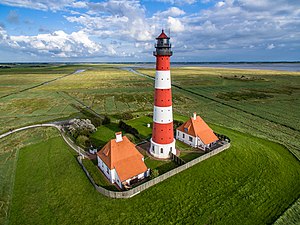Learning patterns/Using drones for aerial photography for Commons and Wikipedia
What problem does this solve?[edit]
Please note: This Learning Pattern is mainly based on texts by Commons User Phantom3Pix and was edited/ translated/ posted by Wikimedia Deutschland (WMDE).
With aerial photos taken via a drone you can present objects of encyclopedic relevance from a completely different perspective compared to conventional photography. Particularly in the case of cultural heritage properties or of nature conservation areas, e.g. during the annual photo contests "Wiki Loves Monuments" and "Wiki Loves Earth", such pictures can provide a significant added value.
However, when dealing with a drone, in addition to some technical hurdles, you may face a jungle of regionally different legal requirements. What permits are required? What costs can be expected, what support options are available and what else is there to consider?
What is the solution?[edit]
What technical requirements are the minimum to take pictures by means of a drone?[edit]
The drone should be GPS controlled so that it maintains its position in the air without manual countermeasures. The camera should have an appropriately high resolution.
In Germany, Switzerland and Austria, volunteers can borrow a photo drone (owned by WMCH) through the joint technical pool of the Wikimedia chapters in these countries.
Which legal requirements exist and how can they be met?[edit]
Basically, anyone who wants to start a photo drone outside of private property (e.g. at the property of a model flying association) requires an appropriate liability insurance. Such insurance, for example, is included in the membership fee of the German model flying association (DMFV). If an additional insurance is required apart from this, depends on the particular model of the photo drone, and especially, on its weight.
In Switzerland, each and every one who wants to fly a drone >500 grams and to take pictures with it, must have a liability insurance (liability coverage in the amount of at least CHF 1M).

In Germany, you do not need special permission if photos are taken for private purposes only. Nevertheless, the agreement of the landowner must be obtained. And, of course, it is also not allowed to spy on your neighbors ;-)
In Sweden it is complex, but best practices have been collected by Wikimedia Sverige.
If photos are taken for commercial use, a general permission for the rise of unmanned aviation systems must be obtained. You can apply for this e.g. at Rhineland-Palatinate’s (German federal state) state office for mobility, department for aviation, at the airport Frankfurt-Hahn. Additionally, the local police station and the town clerk's office should to be informed at least 48 hours before the rise of the drone. Not every federal state accepts a permission obtained in another federal state, so that, for example, a flight across the border from Rhineland-Palatinate federal state to Hesse federal state can be problematic.
Of course, there is a certain disambiguity in the distinction between private and commercial purposes. Some may say the private purpose is limited to a private photo album, but does not cover publications in social networks or even Wikipedia. So, if you want to be 100% safe, before taking the photographs and publishing them on Commons you should organize the following things:
- liability insurance.
- the permission of the local authorities.
- the consent of the landowner.
- notification at the local police and town clerk's office at least 48 hours before the drone is launched.

What other costs arise aside the costs for the technical equipment?[edit]
Liability insurance, including additional insurance for drones of up to 5 kg, costs 50–60 euros per year. The yearly permission fee for launching drones is 150–200 euros, which may be covered by the Wikimedia chapters in Germany, Switzerland and Austria on request.
What practical tips and tricks are to be considered?[edit]
Before actually taking aerial photos with a photo drone, it's useful to practice maneuvering the drone on a big field or meadow.
It's very important to keep visual contact with the drone! Sometimes, this can be quite tricky, because you have to account for the alignment of the photographic frame at the same time. If you want to do that the best way possible, it is really helpful to have a second person on-side to watch the drone and warn of any dangers or occurrences.
Where can I get more information and find competent contacts?[edit]
In Germany, you can approach the Deutscher Modellflieger Verband (German model flying association), and there are many forums and pages in the social web where you can get more detailed information. On Youtube there are some really interesting and good tutorial videos by Arthur Konze. In many German cities, local associations and schools might be useful as well.
When to use[edit]
The information from this learning pattern was used when shooting the Wiki Loves Monuments 2015 winner photo.
Disclaimer[edit]
All legal information included in this text refers only to the laws and regulations in Germany or in Switzerland, is subject to change and may strongly differ in other countries. Please check thoroughly which laws and regulations are valid in your respective region/ country before applying this learning pattern.

